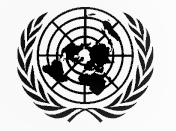
Children play by bullet riddled police station in Gao, Mali
Photo credit: UN Photo/Marco Dormino
Armed violence continues to hamper peace and sustainable development worldwide. Every day, 100 civilians are killed in armed conflicts despite protections under international law. Illicit trafficking of small arms and light weapons facilitates access to arms by terrorists and other criminal actors with devastating impacts for civilians, including women and children.
The nexus between security and development is well illustrated by the Sustainable Development Goals (SDGs), which recognize that fragile and weak institutions threaten not only the security of States, but also the rights and safety of individuals and communities.
The proliferation of various types of weapons has tremendous impacts on many spheres of human life and nature, relating to multiple SDGs, including those relating to peace, justice and strong institutions (SDG 16), reduced inequalities (SDG 10), economic growth (SDG 8), health (SDG 3), gender equality (SDG 5), and safe cities and communities (SDG 11).
Reports of the Secretary-General
Key initiatives
In an annual resolution, the General Assembly showcases the linkage between disarmament and development supported in the 2030 Agenda for Sustainable Development and made explicit in the Secretary-General’s Agenda for Disarmament, launched in 2018.
The Agenda for Disarmament points out four key areas in which disarmament helps achieve sustainable peace and development. These are:
- Reducing and eliminating weapons of mass destruction
- Reducing and mitigating the impact of conventional weapons
- Remaining vigilant regarding new and emerging weapon technologies
- Reinvigorating disarmament institutions and partner with Governments, experts, civil society, women and youth
Specific Sustainable Development Goal (SDG) indicators identify how disarmament and arms control lead to peaceful and inclusive societies, justice and strong institutions (SDG 16). Indicator 16.4, for instance, specifies the significant reduction of illicit arms flows, that otherwise instigate, fuel and prolong armed conflict, terrorism and crime, as an important way to measure progress. Deaths from armed violence can further significantly be reduced through the prohibition and restriction of the use of certain types of weapons, and the establishment of effective controls of arms and ammunition, demonstrated in indicator 16.1. Indicator 16.8 measures the active engagement of all States, specifically developing countries, in multilateral disarmament discussions that can lead to more effective and sustainable policy outcomes. And finally, indicator 16.a informs progress on SDG 16 through the level of the institutional capacity of States to better control arms and ammunition and to engage in military confidence-building measures.
Through Indicator 16.4.2, UNODA, together with UNODC as co-custodian, collects data on the “proportion of seized, found or surrendered arms, whose illicit origin or context has been traced or established by a competent authority in line with international instruments”.
Through various projects and trust funds, UNODA continues to support concrete small arms control initiatives that foster sustainable development around the world. These include the United Nations Trust Facility Supporting Cooperation on Arms Regulation (UNSCAR), but also the newly established Saving Lives Entity (SALIENT), that was brought to life together with UNDP under the Peacebuilding Fund.
Other resources
- At a Glance: Disarmament and Arms Regulation in the 2030 Agenda for Sustainable Development
- Advancing disarmament within the 2030 Agenda for Sustainable Development
- How weapons control fosters development
- UNODA Occasional Papers No 9 | Symposium on the Relationship between Disarmament and Development: Panel Discussion
- Disarmament Study Series No 31 | The Relationship between Disarmament and Development in the Current International Context
- Disarmament Study Series No 15 | Reduction of Military Budgets: Construction of Military Price Indexes and Purchasing-power Parities for Comparison of Military Expenditures
- Disarmament Study Series No 5 | The Relationship Between Disarmament and Development

